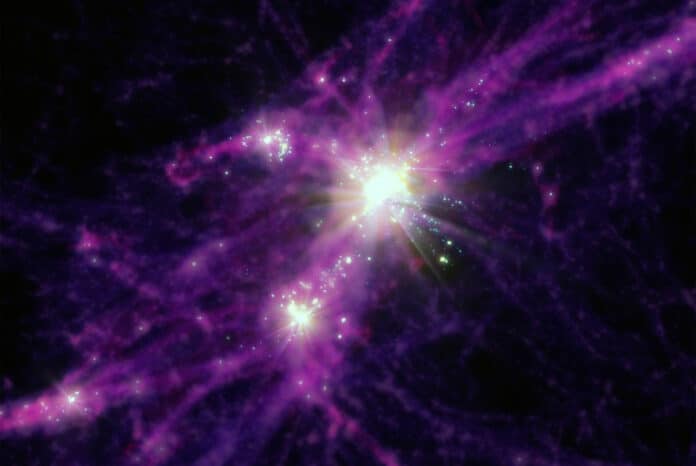JWST’s first images shocked scientists: Young galaxies didn’t seem to have formed so soon after the Big Bang since they were too bright, massive, and developed. It would be comparable to an infant growing into an adult in a matter of years.
A team of physicists led by Northwestern University has found that these galaxies may be smaller than previously thought using new simulations. The latest results imply that less massive galaxies can shine just as brightly from irregular, dazzling bursts of star formation, even though a galaxy’s brightness is typically determined by its mass.
This new study explains why young galaxies appear deceptively massive.
Guochao Sun, who led the study, said, “The key is to reproduce a sufficient amount of light in a system within a short time. That can happen because the system is massive or can produce much light quickly. In the latter case, a system doesn’t need to be that massive. If star formation happens in bursts, it will emit flashes of light. That is why we see several very bright galaxies.”
Cosmic dawn is a period that lasted from roughly 100 million years to 1 billion years after the Big Bang. It is especially marked by the formation of the universe’s first stars and galaxies.
Before the launch of JWST, astronomers knew very little about this ancient period. The JWST brought a lot of knowledge about cosmic dawn.
Sun said, “Before JWST, most of our knowledge about the early universe was speculation based on data from very few sources. With the huge increase in observing power, we can see physical details about the galaxies and use that solid observational evidence to study the physics to understand what’s happening.”
In this new study, scientists used advanced computer simulations to model how galaxies formed right after the Big Bang. Cosmic dawn galaxies created by the simulations were equally luminous to those seen by the JWST.
The simulations are part of the Feedback of Relativistic Environments (FIRE) project. Faucher-Giguère co-founded with collaborators at the California Institute of Technology, Princeton University, and the University of California at San Diego.
The FIRE simulations simulate galaxy formation using cutting-edge algorithms and astrophysical theory. Using these models, scientists may examine how galaxies create, develop, and change shape while considering the energy, mass, momentum, and chemical components returned from stars.
Scientists ran simulations and found that stars formed in bursts — a concept known as “bursty star formation.” Stars form constantly in big galaxies like the Milky Way, and their numbers progressively rise with time. But so-called bursty star formation happens when stars start in an alternating pattern, with many stars forming all at once, then very few stars appearing for millions of years, and then many stars appearing all at once again.
Faucher-Giguère said, “Bursty star formation is especially common in low-mass galaxies. The details of why this happens are still the subject of ongoing research. But what we think happens is that a burst of stars form, then a few million years later, those stars explode as supernovae. The gas gets kicked out and then falls back in to form new stars, driving the cycle of star formation. But when galaxies get massive enough, they have much stronger gravity. When supernovae explode, they are not strong enough to eject gas from the system. The gravity holds the galaxy together and brings it into a steady state.”
The Northwestern researchers are the first to employ thorough computer simulations to demonstrate it is plausible that bursty star formation may be the cause of the exceptional brilliance of galaxies at cosmic dawn, despite other astrophysicists’ hypotheses to the contrary. They were able to do this without introducing any new elements that are inconsistent with our current understanding of the cosmos.
Journal Reference:
- Guochao Sun et al., Bursty star formation naturally explains the abundance of bright galaxies at cosmic dawn, The Astrophysical Journal Letters (2023). DOI: 10.3847/2041-8213/acf85a
